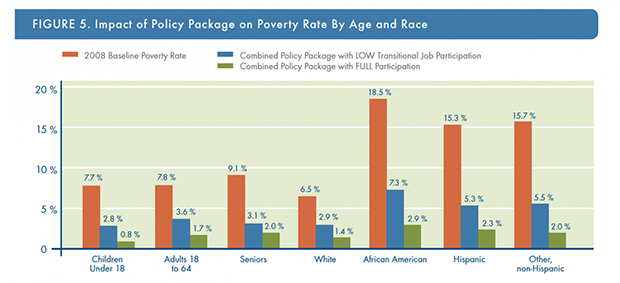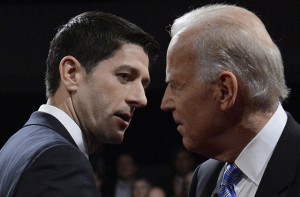We’re proud to collaborate with The Nation in sharing insightful journalism related to income inequality in America. The Nation contributor Greg Kaufmann writes a weekly roundup on the topic, “This Week in Poverty.” Share your thoughts about these must-read stories and always feel free to suggest your own in the comments section.
In last night’s vice presidential debate, Congressman Paul Ryan twice brought up the Republican ticket’s talking point that 15 percent of Americans live in poverty, and twice failed to offer a single idea on how a Romney Administration would help create opportunities for low-income people.
He simply insisted, “We want to get people out of poverty, in the middle class, on to lives of self-sufficiency.”
The good news is that if Ryan truly wants to reduce poverty in a significant way — to make his mark as a champion of low-income people — he need not look any further than the thinkers in his own Badger State.
Four years ago, Community Advocates Public Policy Institute in Milwaukee asked: what would it take to reduce poverty in the state by more than half, to a rate below 5 percent? The institute spoke with a bipartisan group of local and national advisers, narrowing a pool of twenty-five possible policy changes down to four. Last month they rolled out their final proposal. Through sophisticated and widely respected quantitative modeling, Urban Institute demonstrated that the policies would reduce poverty by between 58 and 81 percent in Wisconsin.
The four recommendations are simple and clear:
— Create a senior and disability tax credit
— Expand a transitional, subsidized jobs program
— Increase the minimum wage to $8 an hour
— Reform the Earned Income Tax Credit
These four policy changes were chosen in part because they lend themselves to accurate modeling. Urban Institute concluded that implementation would dramatically reduce poverty for children, adults under 65, and seniors; people of all races, workers and those who can’t work.
“This report is one step in overcoming this fatalism that there’s nothing that can be done about poverty — one step in slaying that myth,” said Conor Williams, an economic policy analyst and consultant on the project.
“We can reduce the poverty rate to under 4 percent or 3 percent if we want to,” said senior fellow David Riemer.
The project looked at the 435,000 people in Wisconsin living below the poverty line in 2008: 100,000 were children; 60,000 were 65 or older; and about 60,000 were disabled and couldn’t work. That left 215,000 people of working age who were capable of working — nearly 20 percent of whom indeed worked full-time, all year long. The next largest group was those who either worked full-time part of the year, or worked part-time throughout the year.
“So the vast majority of adults in poverty are working — and they have both the desire and capacity to work,” said Williams. “The current situation is a market failure, and three of the four policies are small supplements to make the market function correctly so that working people are able to lift themselves out of poverty.”
With the proliferation of low-wage work those kinds of supplements are sorely needed. The Economic Policy Institute reports that 50 percent of jobs in the U.S. pay less than $34,000 per year, and 25 percent pay less than $23,000 annually (less than the poverty level for a family of four).
One key policy that supports low-wage workers is the Earned Income Tax Credit (EITC) — championed by knee-jerk liberals such as Presidents Ford and Reagan. The proposed reforms would provide up to $3,500 per worker, and up to $5,000 for working families with children.
“The current EITC favors families with children, and disfavors childless adults, many of whom are young men,” said Williams. “This new plan represents a significant increase in the tax credits available to childless adults.”
The subsidized transitional jobs program would provide unemployed and underemployed adults with minimum wage jobs. In the past two years, 3,600 workers have participated in a demonstration project in the state, mostly working for small, for-profit businesses. Over 1,400 have gone on to secure unsubsidized employment.
“These are people with significant barriers to employment — they’ve either been out of work for a long time, have low skills, or have a significant criminal record,” said Williams. “But it shows that if you give them the opportunity to work they are as good stewards of that opportunity as the rest of us are.”
Subsidized jobs have been widely hailed by both Democratic and Republican governors — like Haley Barbour and Scott Walker — and the Recovery Act created 260,000 such jobs for low-income adults before Republicans in Congress killed the program. This kind of investment is particularly key in metro areas like Milwaukee, where just 52 percent of African American males in their prime working years were employed in 2010, compared to 85 percent in 1970.
The third proposal that would benefit working adults is to raise the minimum wage to $8.00 an hour. That hardly seems extreme, given that it would be $10.55 an hour if it were adjusted for inflation in the same way that, say, individual campaign contribution limits are.
Williams said that together, all three of these work-related provisions — subsidized jobs, tax credits, and an increased minimum wage — reflect “broad support for the idea that through work people should be able to provide for the basic material needs of their households.”
The final policy — a new senior and disability tax credit — would go to adults receiving Social Security or Supplemental Security Income (SSI), and make up the difference between an individual’s or couple’s resources and a poverty-level income.
The potential outcomes of this proposal are stunning and measurable. Depending on the extent of participation in the subsidized jobs program and existing programs, the 58-82 percent reduction in poverty would mean an overall poverty rate of just 1.5-3.4 percent, including: a child poverty rate that drops from nearly 8 percent (based on 2008 levels) to between 2.8 and .8 percent; an African American poverty rate that drops from 18.5 percent to between 7.3 and 2.9 percent; and a senior poverty rate that falls from 9.1 percent to between 3.5 and 1.7 percent.

Source: Community Advocates Public Policy Institute
The Urban Institute concludes that the four policy changes alone would reduce the number of people in poverty in Wisconsin by between 252,000 and 287,000. If it were combined with full participation in existing programs that help low-income people, poverty would be reduced by 351,000 people.
The federal cost? Between $3 and $5 billion. But what can’t be modeled are the associated cost savings or multiplier effects of the investments. Williams noted, for example, that the fastest-growing departmental budget in the state of Wisconsin over the past twenty years is for the Department of Corrections — now higher than the budget for the entire state university system.
“If you care for the most marginalized you ultimately care for yourselves,” said Williams. “For $10,000 you can find a transitional job for somebody that might otherwise end up costing you $30,000 to incarcerate.”
It’s reasonable to assume there would also be significant savings gained through the huge reduction in child poverty rates. Economist Harry Holzer has put the costs of child poverty nationwide at $550 billion per year, or 3.8 percent of GDP, roughly evenly divided between lost productivity, increased crime-related costs, and increased health care costs.
“It’s a quintessentially American idea to try to extend opportunity as widely and as broadly as possible,” said Williams. “And these 435,000 people who live in poverty in the state of Wisconsin — with a small additional effort — they can be included in the opportunities that most of the rest of us enjoy.”
The focus of Community Advocates Public Policy Institute is now to speak with state legislators to advocate for bills that adopt these policies, even if it happens incrementally.
“Poverty is not inevitable. Our proposal and the Urban Institute analysis show one plausible, simple way to get the job done,” said Riemer. “There may be others. It’s a matter of will. It always has been.”
The Streak Continues: 2008-2012, Will Anyone #TalkPoverty?
There are 46 million people living in poverty — on less than $18,000 a year for a family of three. Twenty million live in deep poverty — surviving on less than $9,000 annually for a family of three. And there are now over 16 million children in poverty — 22 percent of all kids — making them our nation’s poorest age group.
Given these horrific numbers, it is stunning that neither Jim Lehrer nor Martha Raddatz deemed poverty to be an issue worth talking about in the first two debates of the presidential campaign.
I would imagine that it’s not just antipoverty advocates who are disappointed in the lack of real discourse about this issue. In January, a poll conducted for Spotlight on Poverty — an initiative of major U.S. foundations to foster debate on poverty and opportunity during the campaign — revealed that 88 percent of likely voters said a presidential candidate’s position on poverty was “important” in determining their vote; nearly half said it was “very important.”

Vice President Joe Biden and Republican vice presidential nominee Rep. Paul Ryan of Wisconsin shake hands after the vice presidential debate at Centre College. (AP Photo/Pool-Michael Reynolds)
Still, the blame doesn’t lie entirely with the moderators. Just as there were plenty of opportunities for President Obama and Governor Romney to address poverty in a substantive way last week, the same was true in last night’s vice presidential debate.
The Romney-Ryan ticket continues to use the poverty statistic as a bludgeon without offering a single concrete idea on how to create opportunities for low-income people, and without demonstrating the slightest understanding of what people in poverty are experiencing today.
For its part, the Obama campaign seems to have made a decision not to talk about poverty unless asked. For example, when Congressman Ryan said that his faith informs him “about how to take care of the vulnerable, about how to make sure that people have a chance in life,” Biden surely could have seized that opening had he wished to. Yes, the question was about abortion, but he could have succinctly answered and pivoted — looking in the camera the way he likes to and said:
“Look folks, Congressman Ryan talks a good game about taking care of the vulnerable, but here’s what he doesn’t tell you: that repealing Obamacare like they want to would leave 30 million Americans uninsured who would have been insured under our plan. That the Romney Medicaid cuts would leave an additional 14 to 19 million low-income people uninsured. That compensation for disabled veterans — which averages less than $13,000 a year — would be cut by one-fifth to one-third, as would pensions for low-income veterans, which now average just $11,000 a year. How’s that for thanking our veterans for their service? SSI benefits for poor elderly and disabled people — which currently average just $6,000 per year — would also be cut by one-fifth to one-third under a Romney Administration. Folks, we’re talking about elderly and disabled people who are already living well below the poverty line. And why do Governor Romney and Congressman Ryan take an axe to the benefits of people who are in the most desperate situations? That’s the kicker — for one reason, and one reason only: to give more tax cuts to wealthy people who need them the least. Congressman, I got news for you, if that’s your idea of caring for the vulnerable, I think you better revisit the social doctrine of our shared Catholic faith.”
I don’t doubt that Congressman Ryan would have an articulate response to these assertions — one I’d disagree with, no doubt, but articulate nonetheless. But neither campaign is taking any initiative to have this conversation, and the moderators seem to share their view that it’s just not worth talking about.
So now it’s all about Tuesday and CNN chief political correspondent Candy Crowley. This very well might be the last shot, since the final presidential debate will focus on foreign policy. You can check out some of the poverty-related questions TheNation.com has gathered from experts and families — and tweet the ones you want answers to — to @crowleyCNN; or get involved with the Half in Ten campaign and push for a question on child poverty.
I don’t know if we will get them to #TalkPoverty in a substantive way — but I do know there’s a growing number of people trying, and that bodes well as we continue to push for attention to the aspirations of those at the bottom of our economy.
Articles and other resources
“Transporting Black Men to Good Jobs,” Algernon Austin
“Emanuel should give Chicagoans a Voice on City Budget,” Tom Balanoff
“Shrinking Affordable Housing Creates Hardship for Survivors of Domestic Abuse,” Sheila Bapat
“Yes, We Can Fight Inequality….” Annette Bernhardt
“Chicago’s growing racial gap in child poverty,” Steve Bogira (*new weekly blog on segregation)
“9 million elderly at risk of empty pantries,” Alesha Williams Boyd
“Groups Nationwide Challenge Congress Not to Harm Low-income Americans…” Coalition on Human Needs
“Why We Should Care About the Walmart Strikers,” Bryce Covert
“On the Road With Working America,” Josh Eidelson
“Homeless Are Fighting Back Against Panhandling Bans,” Dan Frosch
“US lags behind peer countries in mobility,” Elise Gould
“With shelters full, homeless families have nowhere to go,” Annie Gowen
“Where Are America’s Poor?” Rabbi Steve Gutow
“…Those Who Move to Less-Impoverished Neighborhoods Happier,” Carolyn Johnson
“Hour-Long Special on Choices Faced By People Living in Poverty,” Marketplace Wealth and Poverty Desk
“Poverty is More Than a Number,” Stephanie Schmit
“On Fiscal Cliff, Progressives Issue Poverty Plea,” Jonathan Strong
“Orange County revamps assistance for indigent following lawsuit,” Bernice Yeung
“The Day the Babies Balked: Asking Candidates for Substance as Well as Kisses,” ZERO TO THREE
Report
“Downward Slide: State Child Care Assistance Policies 2012,” Karen Schulman, Helen Blank, National Women’s Law Center. The report finds that child care assistance for low-income working women lags significantly behind demand and jeopardizes the economic stability of millions of families. Families in twenty-seven states are worse off under one or more key child care policies in 2012 than in 2011, and better off in just seventeen states. Twenty-three states have waiting lists or frozen intake for eligible families. Seven states set new eligibility requirements that reduced the number of eligible families. Only one state reimburses providers at the federally recommended level. Securing reliable, affordable child care is inextricably linked to the ability to work for many women, and too many are left with few options.
“America’s Report Card 2012: Children in the US,” First Focus and Save the Children. The nation’s report card is in on how it supports five key areas of a child’s life — and it looks like someone is getting grounded: economic security (D); early childhood (C); K-12 education (C-); permanency and stability (D); health and safety (C+); overall grade (C-).
Vital Statistics
U.S . poverty (less than $23,021 for a family of four): 46.2 million people, 15.1 percent.
Children in poverty: 16.1 million, 22 percent of all children, including more than one in three African American and Latino children. Poorest age group in the country.
Poverty rate among families with children headed by single mothers: 40.9 percent.
Deep poverty (less than $11,510 for a family of four): 20 million people, 1 in 15 Americans.
Twice the poverty level (less than $46,042 for a family of four): 106 million people, more than 1 in 3 Americans.
Jobs in the U.S. paying less than $34,000 a year: 50 percent.
Jobs in the U.S. paying below the poverty line for a family of four, less than $23,000 annually: 25 percent.
Youth employment: lowest level in more than 60 years.
Poverty-level wages, 2011: 28 percent of workers.
Families receiving cash assistance, 1996: 68 for every 100 families living in poverty.
Families receiving cash assistance, 2010: 27 for every 100 families living in poverty.
Gender gap, 2011: Women 34 percent more likely to be poor than men.
Gender gap, 2010: Women 29 percent more likely to be poor than women.
People age 50 and over at risk of hunger every day: 9 million.
Impact of public policy, 2010: without government assistance, poverty would have been twice as high—nearly 30 percent of population.
Impact of public policy, 1964–1973: poverty rate fell by 43 percent.
Quote of the Week
“We aim to shift the debate about poverty to a serious, evidence-based discussion about which combination of policies will work best to greatly reduce poverty.”
—from “Reducing Poverty in Wisconsin,” Community Advocates Public Policy Institute
Research assistance provided by Christie Thompson.


